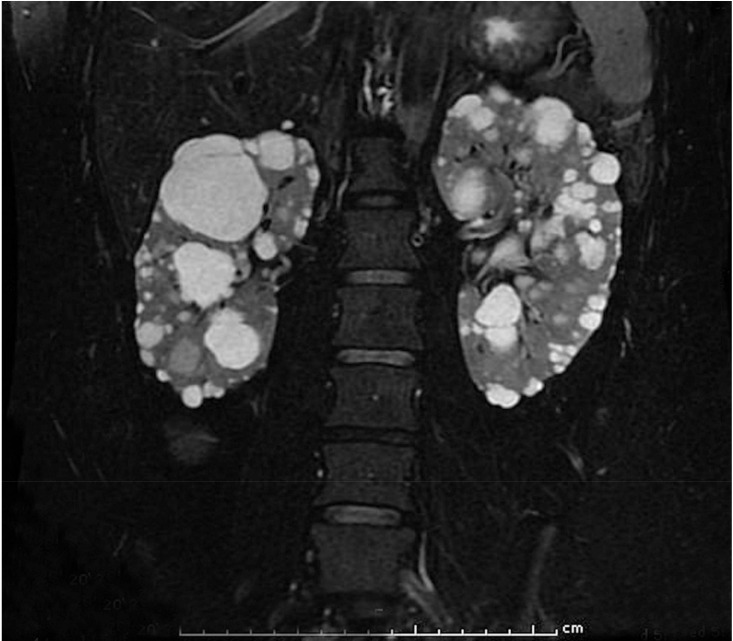Electrolyte Blood Press.
2016 Jun;14(1):11-15. 10.5049/EBP.2016.14.1.11.
Hypokalemic Hypertension Leading to a Diagnosis of Autosomal Dominant Polycystic Kidney Disease
- Affiliations
-
- 1Department of Medicine, Faculty of Medicine Ramathibodi Hospital, Mahidol University, Bangkok, Thailand. chutins@gmail.com
- KMID: 2328425
- DOI: http://doi.org/10.5049/EBP.2016.14.1.11
Abstract
- Autosomal dominant polycystic kidney disease (ADPKD) is the most common inherited renal disease. Hypertension is common and occurs before decline in renal function. However, the coexistence of hypertension and hypokalemia is rare in ADPKD patients. We report on a 32-year-old woman with secondary aldosteronism. Magnetic resonance imaging of the renal arteries revealed multiple cysts of varying sizes in both the kidneys and the liver, compatible with ADPKD. Increased reninangiotensin-aldosterone system activity was secondary to cyst expansion. After initiation of angiotensin II receptor blocker, her blood pressure was controlled without additional requirement of potassium.
Keyword
MeSH Terms
Figure
Reference
-
1. Rimoldi SF, Scherrer U, Messerli FH. Secondary arterial hypertension: when, who, and how to screen? Eur Heart J. 2014; 35:1245–1254. PMID: 24366917.
Article2. Reule S, Sexton DJ, Solid CA, Chen SC, Collins AJ, Foley RN. ESRD from autosomal dominant polycystic kidney disease in the United States, 2001-2010. Am J Kidney Dis. 2014; 64:592–599. PMID: 25134777.
Article3. Spithoven EM, Kramer A, Meijer E, et al. : Renal replacement therapy for autosomal dominant polycystic kidney disease (ADPKD) in Europe: prevalence and survival--an analysis of data from the ERA-EDTA Registry. Nephrol Dial Transplant. 2014; 29(Suppl 4):15–25. PMID: 23986077.4. Ecder T, Schrier RW. Hypertension in autosomal-dominant polycystic kidney disease: early occurrence and unique aspects. J Am Soc Nephrol. 2001; 12:194–200. PMID: 11134267.
Article5. Gabow PA, Johnson AM, Kaehny WD, et al. Factors affecting the progression of renal disease in autosomal-dominant polycystic kidney disease. Kidney Int. 1992; 41:1311–1319. PMID: 1614046.
Article6. Chapman AB, Johnson A, Gabow PA, Schrier RW. The renin-angiotensin-aldosterone system and autosomal dominant polycystic kidney disease. N Engl J Med. 1990; 323:1091–1096. PMID: 2215576.
Article7. Thomas W, Dooley R, Harvey BJ. Aldosterone as a renal growth factor. Steroids. 2010; 75:550–554. PMID: 19782095.
Article8. Doulton TW, Saggar-Malik AK, et al. The effect of sodium and angiotensin-converting enzyme inhibition on the classic circulating renin-angiotensin system in autosomal-dominant polycystic kidney disease patients. J Hypertens. 2006; 24:939–945. PMID: 16612257.
Article9. Amico P, Kalbermatter S, Kiss D. Aliskiren corrects recurrent hyperreninemia and hyperaldosteronism in autosomal dominant polycystic kidney disease. Clin Nephrol. 2009; 72:237–239. PMID: 19761733.10. Chow KM, Ma RC, Szeto CC, Li PK. Polycystic kidney disease presenting with hypertension and hypokalemia. Am J Kidney Dis. 2012; 59:270–272. PMID: 21962616.
Article11. Bobrie G, Sirieix ME, Day M, Landais P, Lacombe M, Grunfeld JP. Autosomal dominant polycystic kidney disease with primary hyperaldosteronism. Nephrol Dial Transplant. 1992; 7:647–650. PMID: 1323077.
Article12. Gejyo F, Ishida K, Arakawa M. Autosomal dominant polycystic kidney disease complicated by primary aldosteronism. Case report and review of the literature. Am J Nephrol. 1994; 14:236–238. PMID: 7977490.13. Liou HH, Tsai SC, Chen WJ, Huang TP, Huang WJ, Chen KK. The association of aldosterone-producing adrenal adenoma in a patient with autosomal dominant polycystic kidney disease. Am J Kidney Dis. 1994; 23:739–742. PMID: 8172219.
Article14. Kao CC, Wu VC, Kuo CC, et al. Delayed diagnosis of primary aldosteronism in patients with autosomal dominant polycystic kidney diseases. J Renin Angiotensin Aldosterone Syst. 2013; 14:167–173. PMID: 22791703.
Article15. Peixoto AJ. A young patient with a family history of hypertension. Clin J Am Soc Nephrol. 2014; 9:2164–2172. PMID: 25092599.
Article16. Ogasawara M, Nomura K, Toraya S, et al. Clinical implications of renal cyst in primary aldosteronism. Endocrine J. 1996; 43:261–268. PMID: 8886619.
Article17. Novello M, Catena C, Nadalini E, et al. Renal cysts and hypokalemia in primary aldosteronism: results of long-term follow-up after treatment. J Hypertens. 2007; 25:1443–1450. PMID: 17563567.
Article18. Schrier RW, Abebe KZ, Perrone RD, et al. Blood pressure in early autosomal dominant polycystic kidney disease. N Engl J Med. 2014; 371:2255–2266. PMID: 25399733.
Article
- Full Text Links
- Actions
-
Cited
- CITED
-
- Close
- Share
- Similar articles
-
- Autosomal Dominant Polycystic Kidney Disease Complicated by Aldosterone-producing Adrenal Adenoma
- A Case Report: Prenatal Ultrasonographic Diagnosis of Autosomal Dominant Polycystic Kidney Disease
- Autosomal Dominant Polycystic Kidney Disease: 2009 Update for Internists
- A Case of Renal Cell Carcinoma in Autosomal Dominant Polycystic Kidney Disease Hemodialyzed
- Genetic diagnosis of autosomal dominant polycystic kidney disease: linkage analysis versus direct mutation analysis


